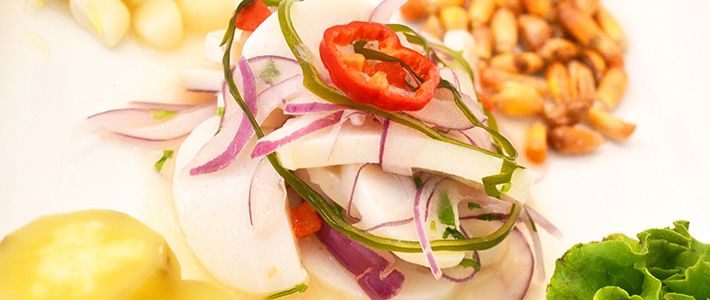
Tying the Cultural Knot in the Kitchen: Japanese-Peruvian Cuisine
Culture Lifestyle- English
- 日本語
- 简体字
- 繁體字
- Français
- Español
- العربية
- Русский
The cultures of Japan and Peru met head-on for the first time in 1899 when 790 Japanese immigrants arrived on the Pacific coast of Peru. Two years before, in 1897, the governments of both countries had agreed on the settlement of Japanese farmers in Peru’s coastal regions. Over 10,000 Japanese immigrants started new lives in Peru over the next several decades, taking in elements of Peruvian culture while continuing to observe Japanese customs. In the area of food in particular, this meeting of cultures has bred what is known as Nikkei culture or cuisine.
Many ethnic Japanese who grew up in Peru are now returning to Japan. One of them is Okinawa-born Miyahira Rosa Hatsue, who runs Inti Raimi,(*1) a restaurant in Kawasaki that offers Peruvian and Nikkei food. Miyahira hopes to acquaint Japanese people with Peruvian culture through the medium of taste.
“People in Japan may be familiar with countries like Chile, Argentina, and Spain,” says Miyahira, “but they didn’t know much about Peru. We felt that the best way to introduce Peruvian culture would be through food.”
Family Ties an Ocean Apart
Miyahira’s grandparents joined the first mass migration to Peru 114 years ago, leaving behind their daughter—Miyahira’s mother—in Japan. They worked on farms for many years before setting up a family-owned bakery. Miyahira was 17 years old when her grandmother’s illness prompted her mother to move to Peru with Miyahira and her younger brother. It was 1964, the year of Japan’s first Tokyo Olympic Games.
 Left: On Miyahira’s wedding day, with extended family. Right: A relative plays the sanshin, a traditional Okinawan instrument, at the wedding party.
Left: On Miyahira’s wedding day, with extended family. Right: A relative plays the sanshin, a traditional Okinawan instrument, at the wedding party.
Arriving in her new home from a not-so-developed Okinawa, Miyahira was astounded by the sheer number of concrete buildings. She began working at her family’s bakery with next to no knowledge of Spanish. “I started out by learning basic words like numbers,” Miyahira says. Soon she married a fellow Okinawan emigrant, with whom she launched a wholesale business. By the time she returned to Japan 27 years later, the country had developed remarkably, and it struck her in much the same way that Peru had many years before.
Miyahira and her family decided to move back to Japan on account of Peru’s unstable economy and the brutality of the radical leftist group Sendero Luminoso (Shining Path), which terrorized Peru from the 1980s to the early 1990s. Quite a few Japanese-Peruvian families were also making the move around 1990 for the same reasons.
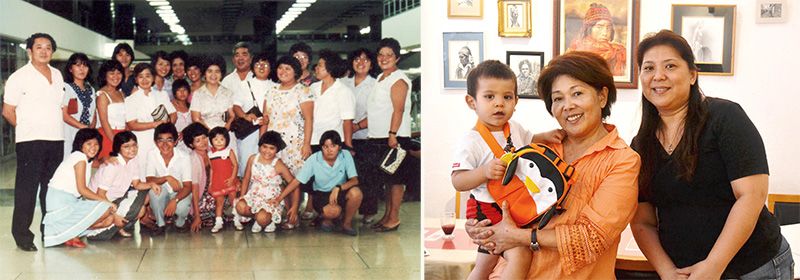 Left: The Miyahira family on the day of their return to Japan. Right: Miyahira, holding her grandchild, with her daughter Miyahira Miyuki.
Left: The Miyahira family on the day of their return to Japan. Right: Miyahira, holding her grandchild, with her daughter Miyahira Miyuki.
Friendly Fusion of Tastes and Cultures
Miyahira initially worked in factories, just like the other returnees and immigrants from Peru. Several years later, noting the increase of returnees, she opened her restaurant.
Miyahira runs Inti Raimi with her daughter Miyuki, who was born in Peru. The restaurant also gives them a means to actively promote Peruvian culture in Japan. At the core of their philosophy is the integration of Japanese and Peruvian cuisine.
“The basic ingredients we use, like fish and meat, are domestic,” explains Miyahira. “But we add distinctly Peruvian seasonings, including several varieties of chili. Our cooks are from Peru, and we don’t serve dishes that have been adjusted to the Japanese palate. We take pride in that.”
It took a while for the Peruvian taste to grown on Japanese customers, Miyahira says: “Of course, our taste is essentially Peruvian, but having lived in Nikkei culture, we also use Japanese seasonings like soy sauce.” For vegetarians and other guests who cannot eat meat, the restaurant uses fried tofu as a beef substitute to make lomo saltado, a popular Peruvian dish with Asian influences.
Miyahira explains, “Our original recipes include a version of the famous ceviche [white fish or octopus marinated in fresh lemon juice] that features the mild flavor of Japanese kamaboko [fish cake]. Another one is Nikkei tiradito, which isn’t quite sashimi but uses raw fish. It’s eaten with a sauce that was invented as a replacement for wasabi, made by mixing the Peruvian pepper aji amarillo and lemon with soy sauce.
“We also offer beers from Peru called Cusqueña and Cristal, as well as other Peruvian drinks, such as Inca Kola [a soda flavored with herbs] and chichi morada [a beverage made from purple corn]. Young Japanese people are acquiring a taste for Peruvian food, and Peruvian cuisine is something of a phenomenon in Japan now.”
Japanese-Peruvian Recipes
Here we introduce some of Inti Raimi’s fusion dishes that combine elements of Peruvian and Japanese cuisine both in taste and in presentation.
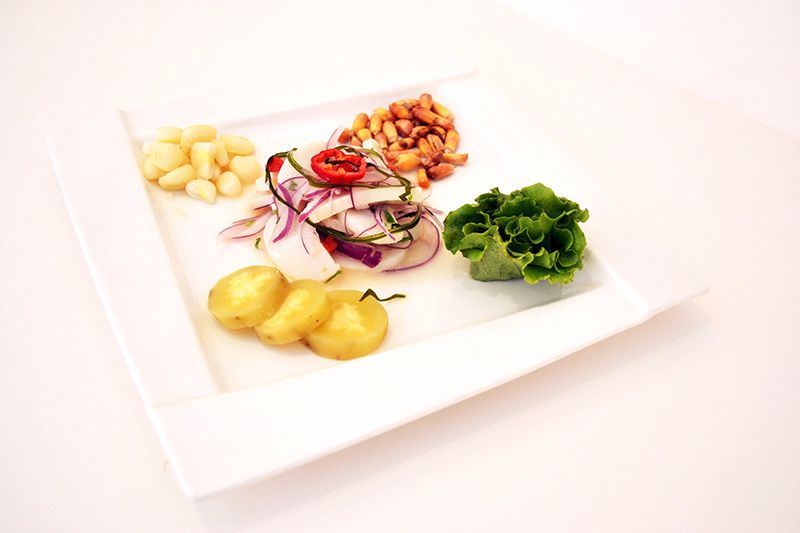 Kamaboko ceviche: Kamaboko (fish cake) flavored with a citrus-based sauce, with two kinds of Peruvian corn on the side. The mildness of the kamaboko goes well with the extra-sour sauce.
Kamaboko ceviche: Kamaboko (fish cake) flavored with a citrus-based sauce, with two kinds of Peruvian corn on the side. The mildness of the kamaboko goes well with the extra-sour sauce.
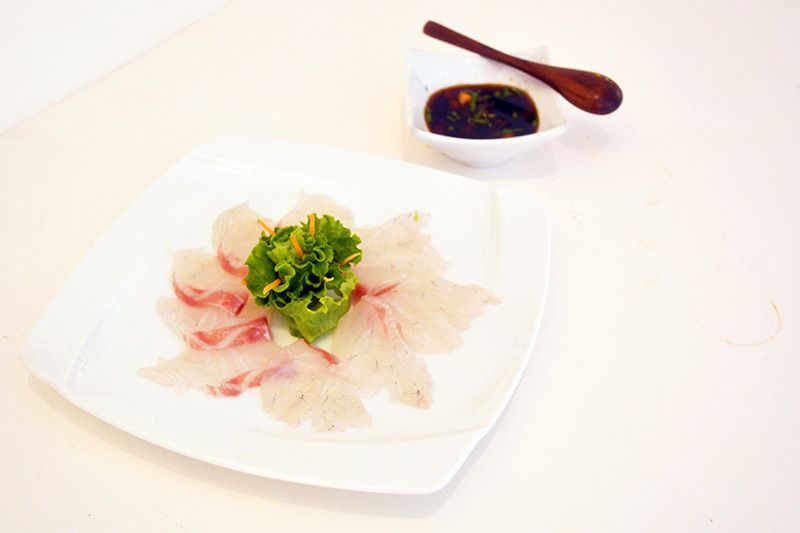 Tiradito: Sashimi-like slices of raw fish garnished with a blend of soy sauce, aji amarillo, and lemon. A refreshing taste.
Tiradito: Sashimi-like slices of raw fish garnished with a blend of soy sauce, aji amarillo, and lemon. A refreshing taste.
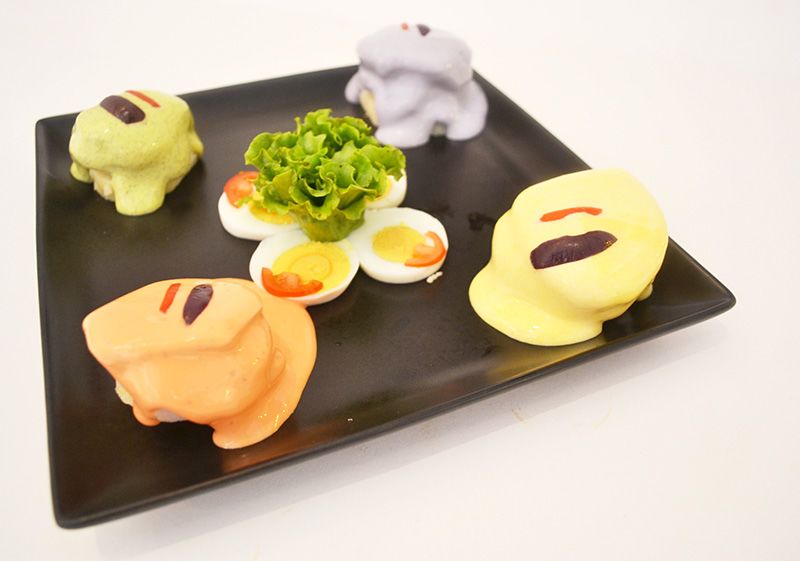 Raimi potato: Boiled potatoes topped with four different sauces—red pepper, olive, huacatay herb, and aji amarillo. A colorful fusion for the eye and palate.
Raimi potato: Boiled potatoes topped with four different sauces—red pepper, olive, huacatay herb, and aji amarillo. A colorful fusion for the eye and palate.
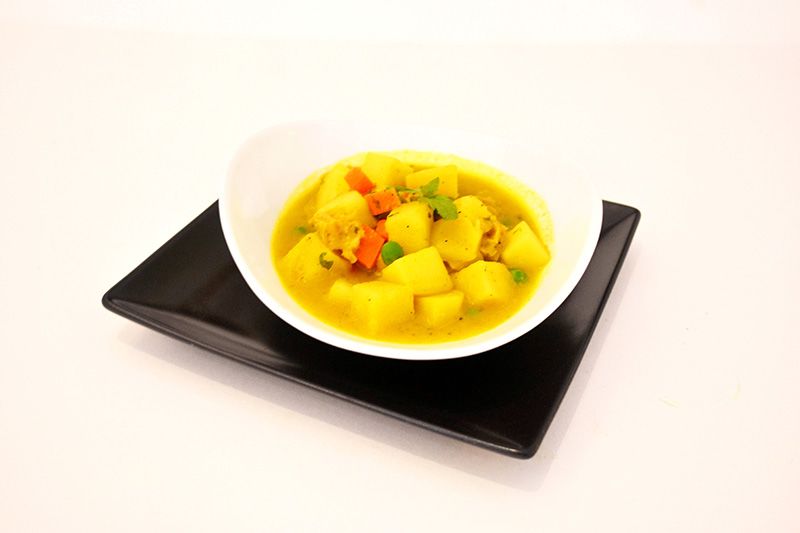 Cau cau: Potato and tripe stewed with aji amarillo, commonly eaten with rice. It can also be cooked with other kinds of meat or seafood.
Cau cau: Potato and tripe stewed with aji amarillo, commonly eaten with rice. It can also be cooked with other kinds of meat or seafood.
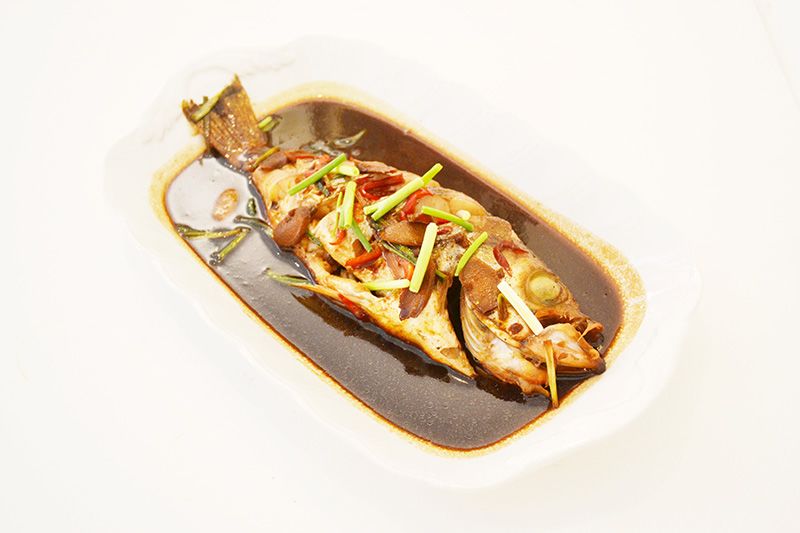 Sillao-simmered fish: Fish simmered in soy sauce. Soy sauce is known in Peru as sillao, a word presumably derived from either the Chinese name for soy sauce, pronounced siyau, or its Japanese name, shōyu. A dish with strong Asian influences.
Sillao-simmered fish: Fish simmered in soy sauce. Soy sauce is known in Peru as sillao, a word presumably derived from either the Chinese name for soy sauce, pronounced siyau, or its Japanese name, shōyu. A dish with strong Asian influences.
Inti Raimi
Address: Sankō Bldg. 1F, 15 Ōmiya-chō, Saiwai-ku, Kawasaki, Kanagawa Prefecture
Tel.: 044-511-4225
Website: http://intiraimi.info/
(*1) ^ Inti Raimi means “festival of the sun” in Quechua. Held on the winter solstice in honor of the god Inti, it is one of the four most important religious ceremonies of the Inca, who dominated the Andes region for centuries.
Japan Okinawa Japanese cuisine Peru Nikkei cuisine Inti Raimi Miyahira immigrants Peruvian cuisine